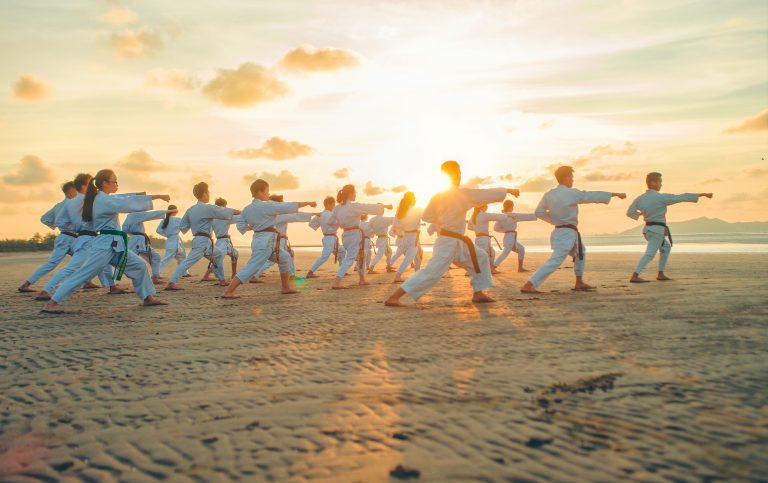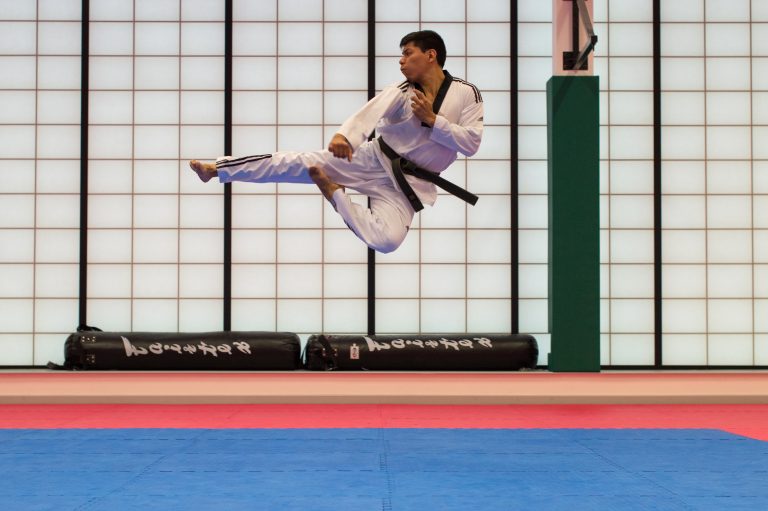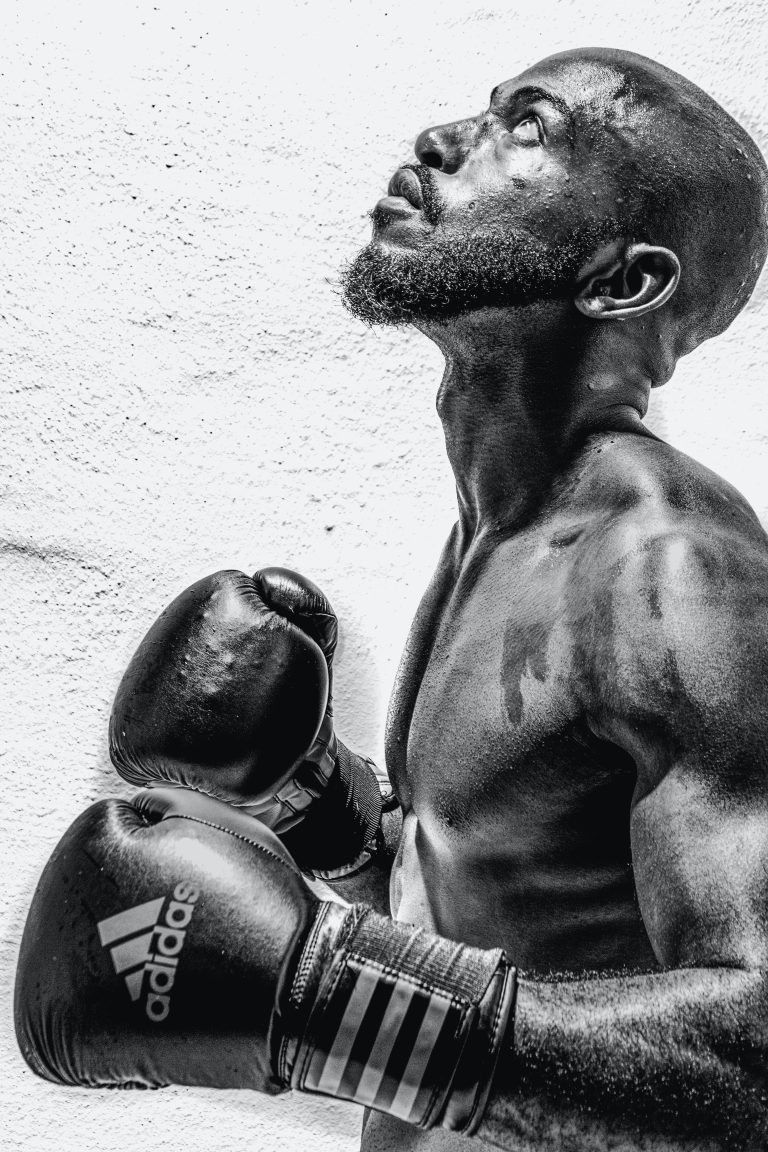Karate Kumite Techniken: Eine Einführung
Karate ist eine Kampfsportart, die in Japan entwickelt wurde. Kumite ist ein zentraler Bestandteil des Karate-Trainings und bezieht sich auf den Kampf gegen einen Gegner. Es gibt viele Karate-Techniken für Kumite, die ein Karateka beherrschen sollte. In diesem Artikel werden wir einen Blick auf die grundlegenden Karate Kumite Techniken werfen.
Jodan Uke (Oberblock)
Der Jodan Uke ist ein Block für Angriffe, die auf den Kopf abzielen. Es ist wichtig zu beachten, dass das Ziel des Blocks nicht darin besteht, den Angriff vollständig zu stoppen, sondern ihn abzulenken und den Angreifer zu desorientieren. Um den Jodan Uke auszuführen, muss der Arm des Karateka in einem Winkel von 45 Grad angehoben werden und die Handfläche neben dem Ohr liegen. Die Bewegung sollte explosiv sein, um dem Angriff zu begegnen.
Gyaku Zuki (Rückwärts Fauststoß)
Gyaku Zuki bezieht sich auf einen Fauststoß, der mit der anderen Hand ausgeführt wird als die vom Körper abgewandte Hand. Es ist wichtig, die Hüfte zu drehen und die Schulter nach vorne zu bringen, um den Stoß effektiver zu machen. Die Hand sollte nicht angespannt sein und die Bewegung sollte schnell und flüssig sein.
Mae Geri (Front Kick)
Der Mae Geri ist ein gerader Vorwärtstritt und einer der grundlegenden Tritttechniken im Karate. Der Tritt sollte mit der Zehenspitze ausgeführt werden und das Knie sollte gestreckt sein. Beim Ausführen des Mae Geri muss der Karateka sicherstellen, dass er seine Hüfte nach vorne und seine Schultern zurückzogen hat. Es ist wichtig, die Hüfte nicht zu weit nach vorne zu bringen, um das Gleichgewicht zu halten.
Morote Zuki (Doppel Fauststoß)
Bei Morote Zuki handelt es sich um einen doppelten Fauststoß, der mit beiden Händen ausgeführt wird. Die Technik erfordert eine sorgfältige Koordination, um sicherzustellen, dass die Hände gleichzeitig zuschlagen. Der Stoß sollte schnell und kräftig sein und sollte auf Brust- oder Bauchhöhe abzielen.
Kakiwake Uke (Innenblock)
Der Kakiwake Uke ist ein Block, der auf Angriffe abzielt, die von der Seite kommen. Es ist wichtig, die Schultern zu lockern und die Hüfte zu drehen, um die Bewegung effektiver zu machen. Die Arme sollten in einem Winkel von 45 Grad so weit wie möglich geöffnet und die Hände seitlich gehalten werden.
Fazit
Kumite kann eine Herausforderung sein, aber mit den richtigen Techniken kann ein Karateka seine Fähigkeiten verbessern. Die oben genannten Karate Kumite Techniken sind nur ein kleiner Teil dessen, was ein Karateka lernen muss, um erfolgreich zu sein. Durch regelmäßiges Training und die Perfektionierung dieser Techniken kann jedoch jeder Karateka seine Fähigkeiten im Kumite verbessern.
What is Karate Kumite?
Karate Kumite is a form of martial arts practiced mainly for self-defense, sport or physical exercise. The term Kumite refers to a form of sparring with an opponent, where two karatekas, or martial artists, engage in a physical combat in a controlled environment. It is practiced under rules that aim to ensure safety and fairness for both athletes. In this blog post, we will discuss some frequently asked questions about Karate Kumite techniques, rules, and etiquette.
What are the basic Karate Kumite techniques?
The basic Karate Kumite techniques include punches, kicks, blocks, strikes, and throws. These techniques are divided into categories such as kihon (basic techniques), kata (pre-arranged sequences of techniques), and Kumite, which refers to sparring. Kumite techniques are further divided into yakusoku Kumite, which is prearranged sparring, and Jiyu Kumite, which is free sparring. Some of the basic Kumite techniques include:
1. Jodan Uke- Upper block
2. Chudan Uke- Middle block
3. Mae Geri – Front kick
4. Yoko Geri – Sidekick
5. Kizama Zuki – Jab punch
6. Gyaku Zuki – Reverse punch
What are the rules of Karate Kumite?
Different karate organizations have different rules for Kumite competitions. However, some of the commonly followed rules are:
1. Participants must wear protective gear such as gloves, mouthguards, and shin guards.
2. Contact is only allowed with certain parts of the body (hands, feet, knees, and elbows).
3. Fouls such as hitting below the belt, attacking joints, using unsportsmanlike conduct, or excessive force can result in penalties, disqualifications, or even bans.
4. The first karateka to score eight points or have more points than their opponent at the end of a time limit wins.
5. You can win a Kumite match by three different methods, either by secured an ippon, which is a full point, a waza-ari, which is a half point, or by having more points than your opponent when there is a tied score, by hantei decision.
What is the etiquette for Karate Kumite?
Karate is not just a physical exercise, but also a way of life that embodies self-discipline, respect, and humility. Etiquette is an essential part of Karate Kumite, especially during training or competition. Some of the etiquette for Karate Kumite are:
1. Bowing to your opponent and referee to show respect.
2. Respecting your opponent’s space and body language.
3. Practicing good sportsmanship, win or lose.
4. Accepting the decision of the referee without argument.
5. Refraining from gloating, criticizing, or belittling your opponent.
What are the benefits of practicing Karate Kumite?
Karate Kumite is a full-body workout that offers several benefits to both physical and mental health. Some of the benefits include:
1. Physical fitness- Karate Kumite is an excellent workout that improves cardiovascular health, muscular strength, endurance, and flexibility.
2. Self-defense- Karate Kumite techniques are effective for self-defense in real-life situations.
3. Discipline- Karate Kumite instills discipline, self-control, and respect for oneself and others.
4. Confidence- Practicing Karate Kumite builds confidence and self-esteem by challenging oneself to push beyond boundaries.
5. Stress relief- Karate Kumite is an excellent way to reduce stress and improve mental health. It helps release endorphins, which reduce stress hormones and promote feelings of well-being.
Conclusion
Karate Kumite is a dynamic and exciting martial arts form that requires dedication, discipline, and practice. Learning the basic Karate Kumite techniques, following etiquette, and understanding the rules of Kumite competition can increase one’s effectiveness and success. Practicing Karate Kumite offers several benefits that can improve physical fitness, mental health, and life skills. Whether you’re looking for self-defense or a fun way to stay fit, Karate Kumite is an excellent choice for people of all ages and backgrounds.
Inhaltsverzeichnis





